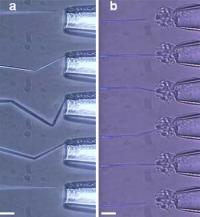Jan 16 2008
University of Pennsylvania engineers and physicians have developed a carbon nanopipette thousands of times thinner than a human hair that measures electric current and delivers fluids into cells. Researchers developed this tiny carbon-based tool to probe cells with minimal intrusion and inject fluids without damaging or inhibiting cell growth.
 From top to bottom: the carbon pipe tip of the CNP buckles when pushed against the wall of a glass pipette and recovers its initial shape once the force is removed. (b) From top to bottom: a CNP penetrates through the membrane of a smooth muscle cell. The cell is held in place by glass micropipette aspiration. Scale bars, 15 µm.
From top to bottom: the carbon pipe tip of the CNP buckles when pushed against the wall of a glass pipette and recovers its initial shape once the force is removed. (b) From top to bottom: a CNP penetrates through the membrane of a smooth muscle cell. The cell is held in place by glass micropipette aspiration. Scale bars, 15 µm.
Glass micropipettes are found in almost every cell laboratory in the world but are fragile at small scales, can cause irreparable cell damage and cannot be used as injectors and electrodes simultaneously. Haim Bau, a professor in the Department of Mechanical Engineering and Applied Mechanics at Penn, and his team developed tiny carbon-based pipettes that can be mass-produced to eliminate the problems associated with glass micropipettes. Although they range in size from a few tens to a few hundred nanometers, they are far stronger and more flexible than traditional glass micropipettes. If the tip of a carbon nanopipette, or CNP, is pressed against a surface, the carbon tip bends and flexes, then recovers its initial shape. They are rigid enough to penetrate muscle cells, carcinoma cells and neurons.
Researchers believe the pipettes will be useful for concurrently measuring electrical signals of cells during fluid injection. In addition, the pipettes are transparent to X rays and electrons, making them useful when imaging even at the molecular level. Adding a functionalized protein to the pipette creates a nanoscale biosensor that can detect the presence of proteins.
“Penn’s Micro-Nano Fluidics Laboratory now mass-produces these pipettes and uses them to inject reagents into cells without damaging the cells,” Bau said. "We are ultimately interested in developing nanosurgery tools to monitor cellular processes and control or alter cellular functions. We feel CNPs will help scientists gain a better understanding of how a cell functions and help develop new drugs and therapeutics."
Just as important as the mechanical properties of carbon nanopipettes, however, is the ease of fabrication, said Michael Schrlau, a doctoral candidate and first author of the study, “Carbon Nanopipettes for Cell Probes and Intracellular Injection,” published in the most recent issue of Nanotechnology. “After depositing a carbon film inside quartz micropipettes, we wet-etch away the quartz tip to expose a carbon nanopipe. We can simultaneously produce hundreds of these integrated nanoscale devices without any complex assembly,” he said.
The next challenge for researchers is fully utilizing the new tools in nanosurgery.
"We will need to go beyond the proof-of-concept, development stage into the utilization stage," Schrlau said. "This includes finding the appropriate collaborations across engineering, life science and medical disciplines."